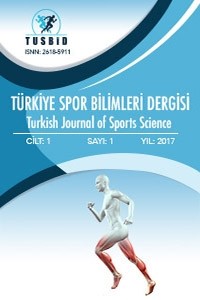Futbolcuların Topla ve Topsuz Yapılan Antrenmanlara Yönelik Görüşlerinin Belirlenmesi
Futbolda Özellikle aerobik kapasite ve anaerobik eşiğin topla yapılan çalışmalarda istenilen yüklenme şiddetine ulaşılamayacağı düşünüldüğünden, dayanıklılığın geliştirilmesinde topsuz yapılan koşular ve interval çalışmalar önerilmektedir. Fakat futbolcuların topsuz yapılan bu tip çalışmalara yönelik görüşleri henüz netlik kazanmamıştır. Bu araştırmanın amacı; futbolcuların topla ve topsuz yapılan antrenmanlarla ilgi görüşlerini belirlemektir. Yapılan araştırmaya Afyonkarahisar ilinde bulunan ve süper amatör kümede oynayan yüz kırk beş futbolcu (yaş: 22.70±4.53 yıl; antrenman yaşı: 8.94±2.01 yıl) katılmıştır. Araştırmada futbolcuların demografik bilgilerinin yanında, topla ve topsuz yapılan antrenmanlarla ilgili görüşlerinin belirlenmesine yönelik sorular sorulmuştur. Futbolcuların %17’si topsuz antrenmanı sevmediğini, %9.7’si ise nefret ettiğini bildirmiştir. Bunun yanında %24,1’i normal şiddete ve sürede topsuz antrenmanı tercih ederken, %75.9’u daha yüksek şiddette ve uzun sürede topla yapılan antrenmanı tercih edeceğini bildirmiştir. Sonuç olarak futbolcuların topla yapılan antrenmanlarda antrenmanın şiddeti yüksek ve süresi uzun olsa da topla yapılan antrenmanları daha fazla istedikleri görülmüştür. Literatürde topla yapılan dar alan oyunları ve drillerdeki yüklenme şiddetinin topsuz antrenmana göre daha yüksek olduğu bildirilmektedir. Futbolcuların topla yapılan çalışmalara olan isteklerinin motivasyon aracı olarak kullanılması ile antrenman sayısının düşük olduğu amatör takımlarda çalıştırıcıların futbolcularda fiziksel, teknik ve taktik özellikleri kombine bir şekilde geliştirebilmeleri için doğru şekilde planlanmış topla yapılan dar alan oyunları ve drilleri kullanmaları önerilmektedir.
Anahtar Kelimeler:
Futbol, Topsuz Antrenman, Yüklenme Şiddeti
Determination of the Opinions of the Soccer Players Regarding the Training With and Without Balls
Running and interval exercises without a ball is an important part of the training in football. Since aerobic capacity and anaerobic threshold cannot be achieved in trainings performed with the ball, it is recommended that running and interval based exercises without a ball are performed to improve endurance. However, the opinions of footballers about this type of exercises without a ball have not been clarified yet. The purpose of this study was to determine the opinions of football players regarding exercises without a ball. 145 soccer players (age: 22.70 ± 4.53 years; training age: 8.94 ± 2.01 years) in Afyonkarahisar province participated in the current study. In addition to demographic information, questions were asked to determine the opinions of the players about the exercises with and without balls. 17% of football players reported that they did not like to train without balls while 9.7% of them reported that they hate that. In addition, while 24.1% preferred to exercise without a ball during normal intensity and duration, 75.9% reported that they would prefer training with a ball in higher intensity and longer duration. As a result, it was seen that football players wanted to conduct training with a ball more even if the training was high intensity and the duration was long. It has been reported in the related literature that the load intensity of small side games and drills is higher in exercises with a ball than the exercises without a ball. It is suggested that amateur teams with low training numbers should use correctly planned small side games and drills in order to improve the physical, technical and tactical characteristics of footballers in combination using their opinions regarding exercises with a ball as a motivation tool.
Keywords:
Football, Without a ball, Training intensity,
___
- Aguiar, M., Botelho, G., Lago, C., Maças, V., & Sampaio, J. (2012). A review on the effects of soccer small-sided games. Journal of human kinetics, 33, 103-113.
- Bangsbo, J. (1994). Fitness training in football: a scientificapproach. AugustKroghInst.,University of Copenhagen.
- Billat, L. V. (2001). Interval training for performance: a scientific and empirical practice. Sports Medicine, 31(1), 13-31.
- Helgerud, J.,Engen, L. C., Wisloff, U., &Hoff, J. (2001). Aerobic endurance training improves soccer performance. Medicine and science in sports and exercise, 33(11), 1925-1931.
- Hoff, J.,Wisløff, U., Engen, L. C., Kemi, O. J., &Helgerud, J. (2002). Soccer specific aerobic endurance training. British journal of sports medicine, 36(3), 218-221
- Little, T.,& Williams, A. G. (2006). Suitability of soccer training drills for endurance training. TheJournal of Strength & Conditioning Research, 20(2), 316-319.
- Little, T.,& Williams, A. G. (2007). Measures of exercise intensity during soccer training drills with Professional soccer players. The Journal of Strength & Conditioning Research, 21(2), 367-371., 2007
- Little, T. (2009). Optimizing theuse of soccer drills for physiological development. Strength & Conditioning Journal, 31(3), 67-74.
- Rampinini, E.,Impellizzeri, F. M., Castagna, C., Abt, G., Chamari, K., Sassi, A., &Marcora, S. M. (2007). Factors influencing physiological responses to small-sided soccer games. Journal of sports sciences, 25(6), 659-666.
- Reilly, T.,&Ball, D. (1984). The net physiological cost of dribbling a soccer ball. Research Quarterly for Exercise and Sport, 55(3), 267-271.
- Reilly, T.,& White, C. (2005). Small-sided games as an alternative to interval-training for soccer players. Science and football V, 355-8.
- Sassi, R.,Reilly, T., &Impellizzeri, F. (2005). A comparison of small-side games and interval training in elite Professional soccer players. Science and football V. Oxon: Routledge, 352-4.
- Wisloeff, U. L. R. I. K.,Helgerud, J., &Hoff, J. (1998). Strength and endurance of elite soccer players. Medicine and science in sports and exercise, 30, 462-467.
- Başlangıç: 2017
- Yayıncı: İrfan YILDIRIM
Sayıdaki Diğer Makaleler
Üniversite Öğrencilerinin Boş Zaman Engellerinin İncelenmesi (Bartın İli Örneği)
Adem SOLAKUMUR, Güçlü ÖZEN, Nuh Osman YILDIZ, Yılmaz ÜNLÜ
Derya Selda SINAR, Nasuh Evrim ACAR, İrfan YILDIRIM
Futbolcuların Topla ve Topsuz Yapılan Antrenmanlara Yönelik Görüşlerinin Belirlenmesi
Üniversite Öğrencilerinin Boş zaman Anlamlarının İncelenmesi
